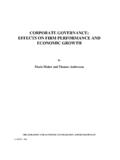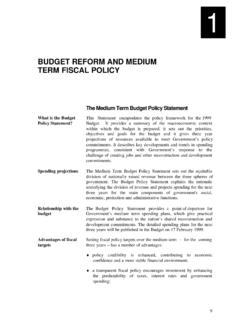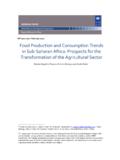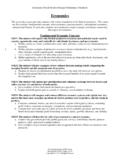Transcription of Ch2 edit 2-5 - National Treasury
1 92 Economic outlook In brief South Africa s projected GDP growth for 2017, forecast at per cent at the time of the 2017 Budget, has been revised down to per cent. Over the medium term, GDP growth is expected to increase slowly, reaching per cent in 2020. Despite substantial risks, the global economic outlook is improving, with growth of per cent forecast in 2018. Higher global growth can benefit South Africa s medium- to long-term growth prospects if the country can boost investment and export competitiveness. Concerns about policy and political uncertainty, along with weak domestic demand, weigh heavily on business and consumer confidence, deterring investment and job creation.
2 Government s economic policy, guided by the objectives of the National Development Plan, centres on inclusive growth, transformation and competitiveness. Progress has been registered on the 14 confidence-boosting measures announced earlier this year. A series of microeconomic reforms would provide impetus to confidence and investment. Transformation, inclusive growth and competitiveness The South African economy grew by an annual average of per cent between 2010 and 2016, well below the target of per cent envisaged in the National Development Plan (NDP). Per capita GDP has declined for two consecutive years, severely constraining efforts to transform the economy, and threatening the sustainability of the public finances.
3 Persistently weak economic growth reinforces the country s legacy of socioeconomic exclusion. Today, million South Africans are living in poverty. Unemployment is per cent the highest level since September 2003. The share of total income going to the top 10 per cent of income earners is between 60 and 65 per cent. Wealth inequality is even more pronounced. Low levels of economic opportunity for a large proportion of the population undermine growth potential and the realisation of the constitutional vision of a more equal society. Slow economic growth severely constrains efforts to transform the economy 2017 MEDIUM TERM BUDGET POLICY STATEMENT 10 Government is focused on inclusive growth, transformation and competitiveness.
4 These three policy objectives form a virtuous circle. Inclusive growth reduces poverty and inequality, and provides the resources to support critical social spending. Broad-based economic transformation opens up the economy to those previously marginalised, generating new businesses and wealth. A competitive economy sells goods and services to the rest of the world and attracts investment to support its own development. Guided by the NDP and the nine-point plan announced in February 2015, government aims to break down structural impediments to new economic activity, deconcentrate industries dominated by few participants, accelerate the inclusion of millions of black South Africans into jobs and businesses, and return to a path of rising incomes for all.
5 The central challenge for economic policy remains effective implementation. Rebuilding confidence Business and consumer confidence have been exceptionally weak in recent years, with direct consequences for investment, job creation and household spending. At present, concerns about policy and political uncertainty, along with weak domestic demand, weigh heavily on business and consumer confidence. Figure Business confidence and private investment Source: RMB/BER Business Confidence Index and Statistics South Africa Delays in finalising key regulatory processes, as well as a pattern of poor governance in several large state-owned companies, contribute to concerns about policy uncertainty.
6 Addressing these concerns would bolster confidence, supporting higher levels of investment and growth. Restoring South Africa s potential growth rate, which has fallen below 2 per cent since 2014, requires additional policy measures. Rapid implementation of a range of microeconomic reforms, as outlined in the NDP, would boost confidence and provide support to the economy. Inclusive growth, transformation and competitiveness form a virtuous circle Weak business and consumer confidence reduce investment, job creation and household spending CHAPTER 2: ECONOMIC OUTLOOK 11 South Africa s macroeconomic framework is underpinned by fiscal sustainability and credibility, inflation-targeting and a flexible exchange rate.
7 This approach protects the public finances for generations to come, and shields businesses and households from a range of economic shocks. Update on government s short-term confidence-boosting measures Restore the sustainability of fiscal policy: The Budget Facility on Infrastructure run by the National Treasury and the Presidential Infrastructure Coordinating Commission received 59 project submissions with an aggregate funding requirement of R135 billion. Several projects have been recommended for detailed appraisal. Negotiations on the next public-service wage agreement are under way. Promote transformation and competitive outcomes by implementing sector reforms: The Preferential Procurement Policy Framework Act Regulations took effect on 1 April 2017.
8 The Financial Sector Regulation Act was signed into law on 21 August 2017. The Government Technical Advisory Centre has been commissioned to set up a fund to benefit small and medium enterprises, with a particular focus on start-ups. Manage fiscal and economic risks associated with state-owned entities: Government granted South African Airways billion to address debt obligations. This allowed SAA to avoid default, roll over some debt and continue negotiations with lenders. A permanent chief executive officer has been appointed and the appointment of a chief restructuring officer is under way. A private-sector participation framework and a template to determine and cost developmental mandates have been approved by Cabinet.
9 An energy task team resolved not to provide balance sheet support to Eskom. The Minister of Energy announced that Eskom will sign power-purchase agreements with independent power producers at a tariff not exceeding 77c/kWh. Create policy certainty by finalising key legislative and policy processes: The Council for Scientific and Industrial Research completed a study on spectrum availability and open access. The Competition Commission launched a market inquiry to investigate data prices. Draft legislation is being finalised to facilitate the licensing of Postbank. Implementation of the revised Mining Charter has been postponed to December 2017.
10 Government is consulting stakeholders on the Regulation of Agricultural Land Holdings Bill. Global outlook The world economy continues to strengthen. According to the International Monetary Fund (IMF), global growth is projected to reach per cent in 2017 and per cent in 2018, up from per cent in 2016. The outlook largely reflects a recovery in demand and trade in Europe and Asia. World trade volumes are expected to increase by per cent in 2017. Low interest rates in the United States, Europe and Japan remain supportive of growth. The euro area should benefit from strong domestic demand, and better-than-expected growth in Japan s net exports will improve its performance in 2017.

















